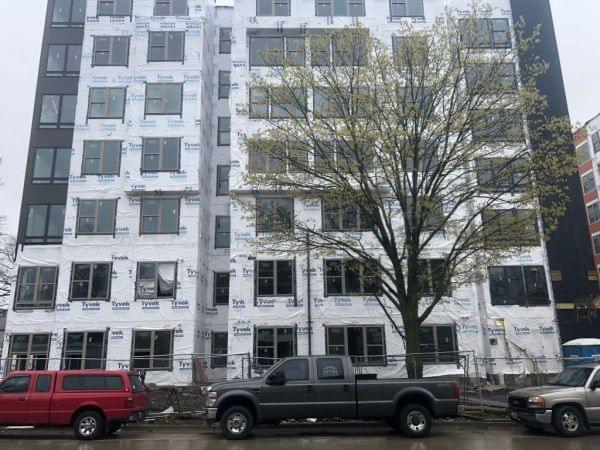Ask The Newsroom: What Are Champaign And Urbana Doing To Create More Affordable Housing?

A new apartment building under construction near the University of Illinois Urbana campus. Kristin Walters/Illinois Newsroom
Illinois Newsroom has been covering the struggle to find affordable housing around the state. The lack of funding to build housing for people with low-incomes is one challenge. But city governments can influence where and how housing is built through their zoning rules. Allowing more multi-family structures opens neighborhoods up to people who cannot afford a downpayment for a single-family home.
Responding to a call for questions about affordable housing, Adani Sanchez asked: “What are [Champaign-Urbana] doing in terms of zoning to create more affordable housing? What can residents do to encourage more affordable housing to be built in neighborhoods that are traditionally single family homes?”
To answer these questions, Illinois Public Media's Anna Casey sat down with Ben LeRoy, associate planner for the City of Champaign. Below is an edited transcript of our conversation.
What is Champaign doing in terms of zoning to create more affordable housing?
“Two years ago, we ramped up an overhaul of our zoning code in the core of our community: campus town, downtown, midtown areas. We made significant changes, including eliminating the parking space requirements, limiting the open space requirement, reformulating how we allow density, and expanding the areas that are zoned central business, which is our most permissive zoning district in terms of use that’s allowed.
“Those are really big steps in terms of achieving affordability and in terms of promoting reinvestment in those areas, promoting a high quality urban style of development as opposed to forcing a suburban style of development into the core of the community.”
Parking requirements and affordability
“Our parking requirement for apartments used to be one parking space per two bedrooms–basically half a space per person. That was producing way more parking than residents were demanding and that residents were using. Each parking space underground costs $15-20,000 and so you stack up 30, 50, 100 of those in the building and then they don’t even get used by residents. That’s a lot of extra costs that the developer has to recoup in terms of increased rents. So getting rid of those requirements has been huge in terms of affordability.”
Examples from other cities
“Other cities have been taking the bull by the horns a lot more aggressively in terms of affordability. Minneapolis in particular adopted a new comprehensive plan that basically eliminated single family zoning across the whole city. It made triplex, three unit buildings, the lowest by-right density that’s allowed. That’s really unusual for American cities.
“More and more American cities are realizing that having 80 percent of your residential land zoned for single family houses only has really negative impacts on affordability.”
What can residents do to encourage more affordable housing to be built in neighborhoods that are traditionally single family homes?
“When there’s a discussion about allowing [the construction of] a small apartment building near a single family neighborhood, opponents will come out. They’ll turn out and speak out against it. You don’t get people speaking out for it. So speaking out in favor of housing is really important.
“I think it’s also important for people to recognize that the type of housing we allow in neighborhoods has an impact on the type of people we allow to live in our neighborhoods. In other words: there are lots of people who, whether by choice or by necessity, can’t afford to buy their own single family home.
“When we ban apartments, when we ban even duplexes from neighborhoods, it means that the only people who can live in that neighborhood are people who can afford the luxury of having their own lot and their own house.
“There are a lot of well-intentioned people who support housing affordability generally. But if a duplex were proposed on their block, they would fight it tooth and nail. And we have to realize that our neighborhoods in our city are for everyone. There is a concept of the right to the city and its concept of housing being a human right. And if those are things that resonate with you you have to accept the fact that your block might not stay single family forever.”
In Champaign
“In the next few months for the Champaign City Council, there’s a goal setting process where the council will set its goals for the next two years, and those goals really dictate the work program for the entire city staff.
“We wish we had unlimited resources of the city and unlimited time, but we don’t. We have to prioritize what comes out of that goal setting process. And during that goal setting process, the city council members absolutely pay attention to what they’re hearing from their constituents.
“I urge people to pay attention to the news media and pay attention to the City’s website when they hear about goal setting going on.”

